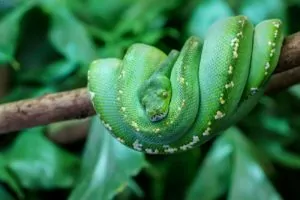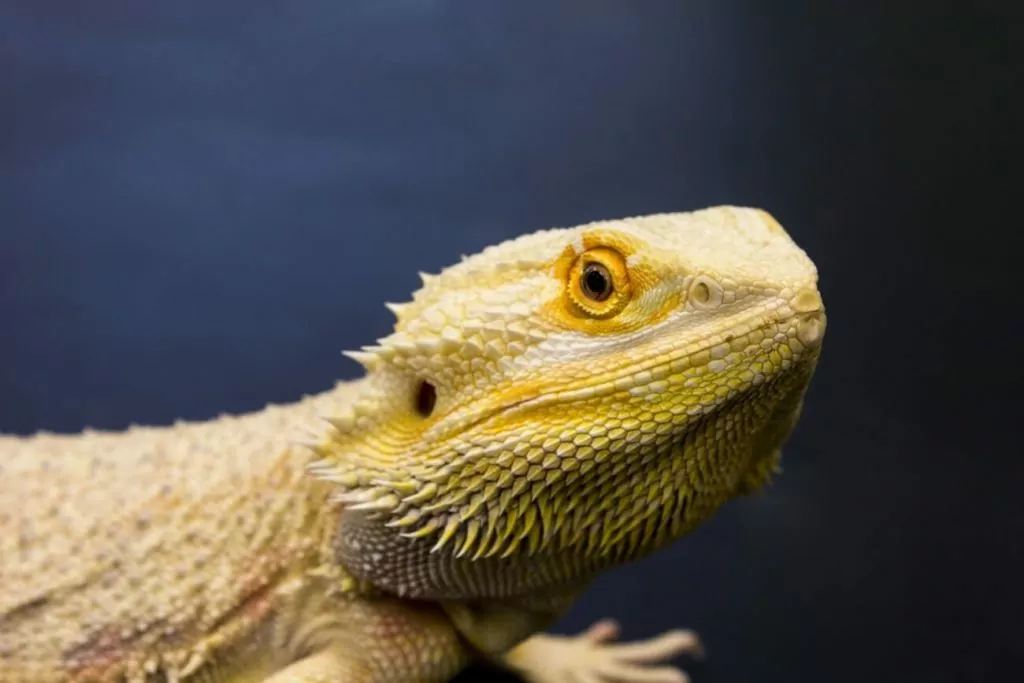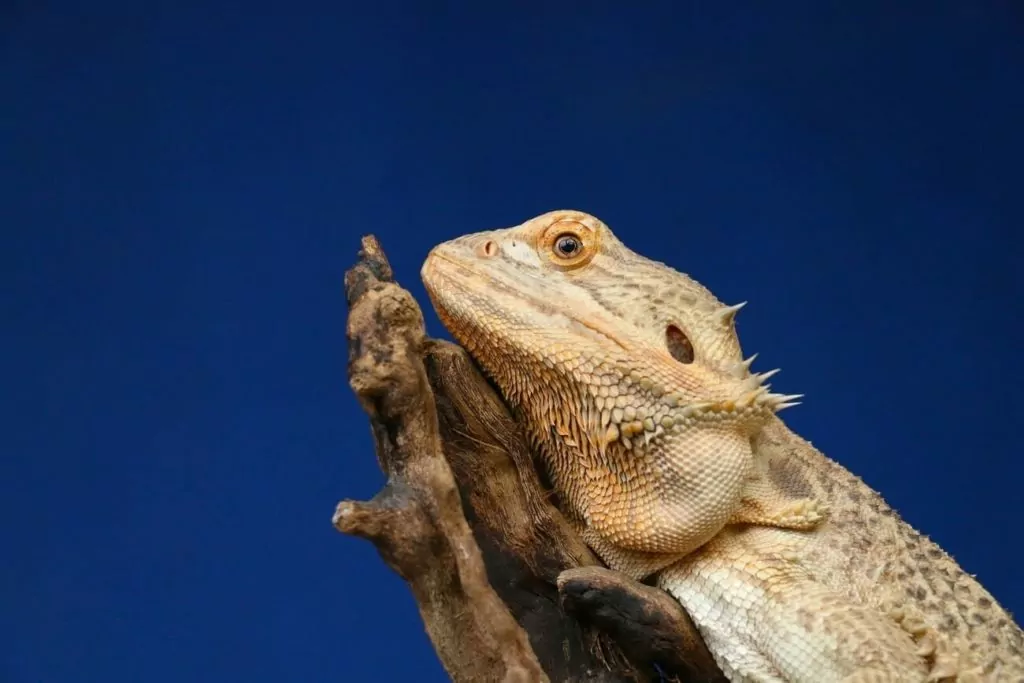The best pet snakes all have something to offer. They’re either great for beginners due to their ease of care, or they have a unique look and behavior that makes them stand out.
With so many types of snakes to choose from, we wanted to make the decision process a little easier for you by putting together this list.
Enjoy!
Corn Snake
The trusty corn snake is an incredibly popular species in the pet trade. It’s often the very first species that snake lovers get the opportunity to care for. Revered for their docile nature, this is one of the best pet snakes for beginners.
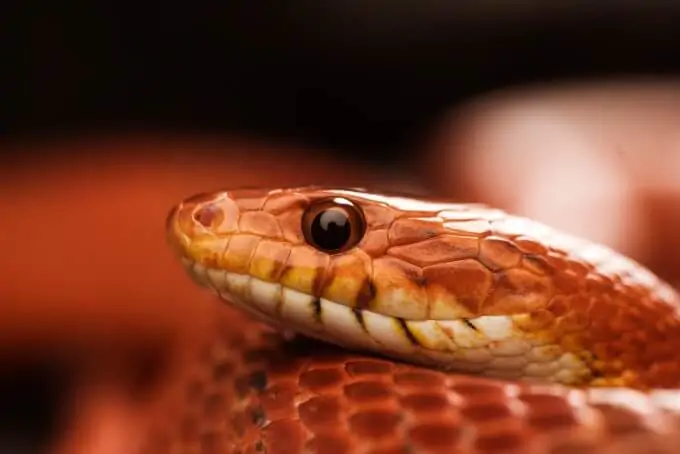
However, they’re loved by collectors and seasoned reptile enthusiasts, too. These reptiles are easy-going and don’t mind gentle handling.
Corn snakes only reach lengths of three to five feet when fully matured. Some may get slightly bigger, but the species is on the smaller side compared to other popular snakes (which is another good starter snake).
They can also take on a spectrum of colors. The standard colors are red-orange, orange-yellow, and black. However, several additional morphs exist. Thanks to this species’ willingness to breed in captivity, selective breeders have come up with some gorgeous color variations.
You can get this type of pet snake with vivid stripes, muted diamond patterns, and more. Leucistic and albino morphs are popular as well.
Western Hognose Snake
The western hognose is an interesting species with some quirky behaviors. The reptiles are native to the Great Plains of America. Oftentimes, they’re mistaken for rattlesnakes.
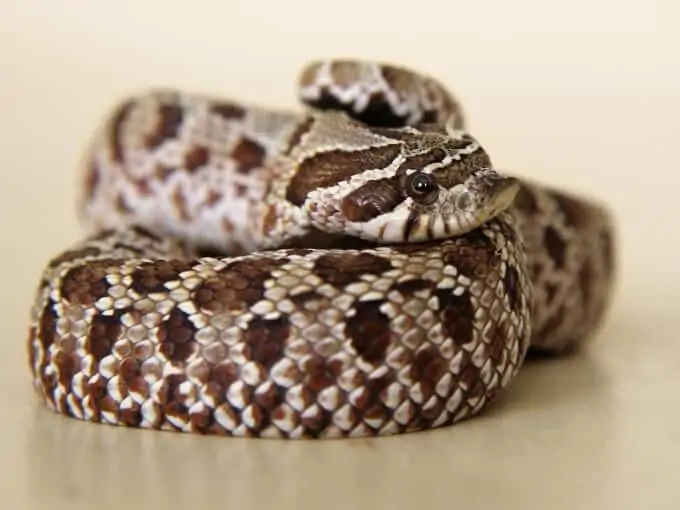
Western hognoses have a similar coloration to deadly rattlers. This includes a body covered in tan, gray, or olive green. However, the head of this species is very distinct.
Rather than the traditional triangular-shaped head of most snakes, western hognoses have an upturned snout. The subtle point on their snouts helps the snake burrow in the sand for protection.
These are good pet snakes because they’re usually very docile in captivity. However, they can exhibit some alarming behaviors when caught off guard!
The snake will often flatten its body to create a cobra-like hood. In some cases, it might even roll over on its back and open its mouth to feign death! This behavior is a defense mechanism to ward off predators.
Ball Python
Is there a species more iconic than the ball python? This species is very widespread in the pet snake community. A great (and popular) option for beginners, it’s also a favorite among experienced owners.
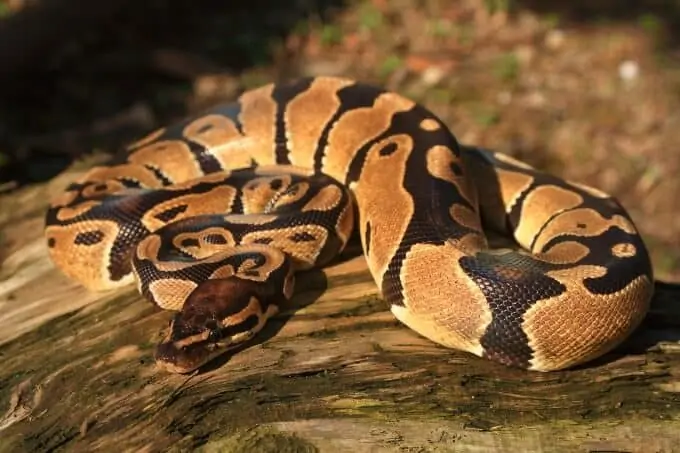
Ball pythons are native to Central and Western Africa. Most of the snakes you see in the trade these days are captive-bred. In fact, the species is often selectively bred to create new morphs.
When it comes to color and pattern, there are many different ball python morphs available. The standard coloration consists of brown, black, and gray. But more exotic morphs like axanthic, ivory, and butter ball pythons are available, too.
Contrary to popular belief, ball pythons aren’t always up for handling (this is something beginners often learn the hard way). It takes time to build trust and get the snake comfortable with human interaction.
Make no mistake: ball pythons can bite when threatened. Fortunately, most bites aren’t a major cause for concern.
Milk Snake
Milk snakes are another brightly colored pet snake species that can add tons of beauty to the right enclosure. Typically, they have stripes of red, black, and yellowish-orange. However, several color morphs do exist.
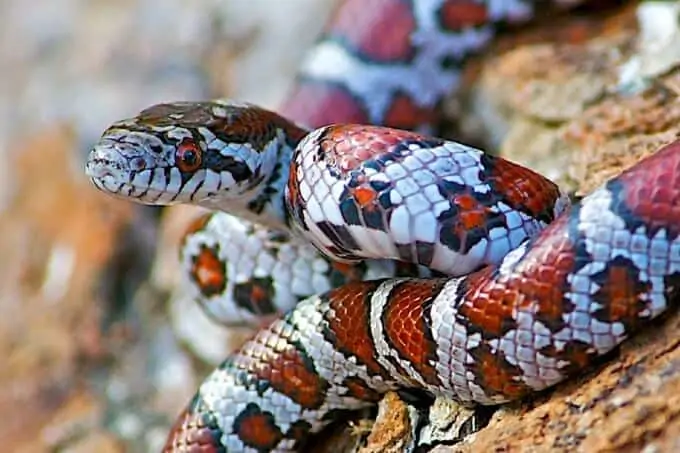
In the wild, milk snakes inhabit many regions around the world. You can find them through most of the continental United States, Central America, Canada, and northern countries in South America. They’re very widespread. But even still, the species remains popular in the reptile trade.
These types of snakes can get quite big. Larger specimens can reach lengths of more than four feet! As a result, they require a sizable enclosure to stay healthy.
Milk snakes are terrestrial and mostly nocturnal. Throughout the day, the snake will rest and remain hidden. When they are out and about, milk snakes still try to be secretive and blend in with their surroundings.
Children’s Python
Native to North and West Australia, the Children’s python is a smaller alternative to other popular python species. Sometimes referred to as the mini python, these stay around 36 to 40 inches long.
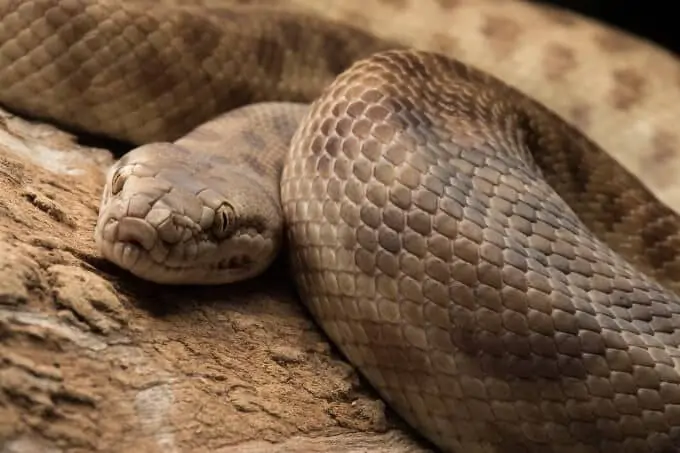
They’re easier to manage than their larger cousins. This applies to both handling and enclosure requirements.
These are some of the best pet snakes because they can live comfortably in relatively small terrariums. Not only that, but males and females can cohabitate without any issues. But be warned: This will lead to breeding!
In terms of behavior, Children’s pythons are very relaxed. They might attempt to bite every once in a while, but the behavior is usually only a feeding response. You can take the steps to avoid this by feeding the snake in a separate enclosure.
African House Snake
The African house snake might not be as colorful as some other species. But it makes an excellent pet all the same!
These reptiles are native to sub-Saharan Africa. They’re a highly adaptable species that can live in a wide range of environments. In the wild, many will end up living around human dwellings!
The snake is completely harmless. They can get nervous around loud noises or unfamiliar environments. However, their first instinct in times of trouble is to flee rather than bite.
The body of the snake is relatively muted. It’s covered in a rich shade of brown. The only distinct pattern is on the head and back. A thin stripe of tan or white runs from the top of the head all the way to the tip of the tail.
California Kingsnake
If you’re a fan of all things dark and mysterious, the California kingsnake is for you! This gorgeous species is covered in stripes of black or dark brown and white. It’s eye-catching, and one of the best pet snakes for beginners.
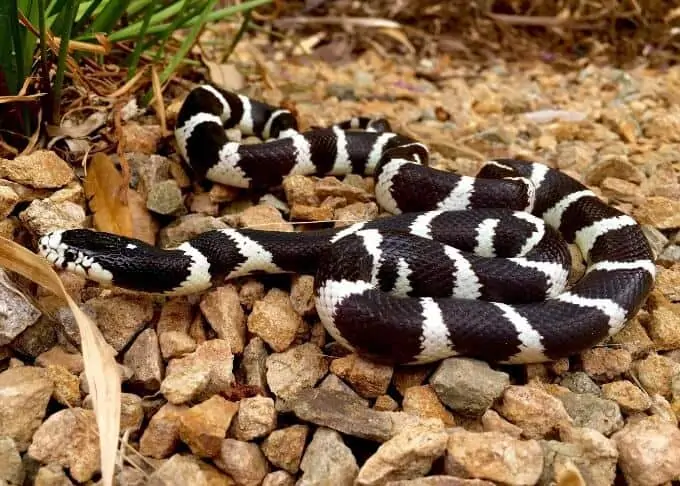
As their name would suggest, California kingsnakes are native to the west coast of the United States. In addition to California, they’re found in Oregon, Nevada, and Arizona.
With an average lifespan of more than 20 years, this snake is one that requires a lot of commitment to care for. Luckily, they’re quite easy when it comes to husbandry.
They’re also very friendly. After settling in their new homes, these pet snakes quickly get comfortable with handling.
That said, the California kingsnake isn’t as friendly towards others. The species can exhibit some cannibalistic tendencies, so housing more than one snake together is a bit no-no!
Rough Green Snake
The rough green snake is one of the most accessible types of pet snakes on the market. The snakes are sold at a very low price. Unfortunately, this has caused some issues with the population as a hold.
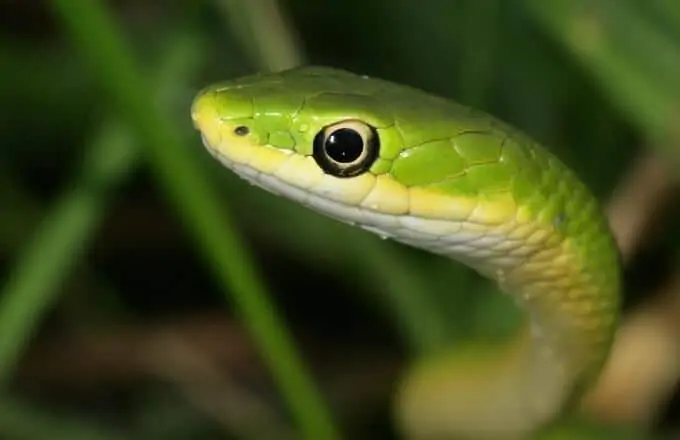
Because they’re so affordable, many inexperienced reptile enthusiasts purchase them without any knowledge of how to care for them.
With poor care, rough green snakes are prone to disease and early death. They’re very susceptible to stress. As a result, they require a pristine environment to make them feel comfortable.
Rough green snakes come from wetlands and forests. They do best in enclosures with dense vegetation and plenty of places to hide.
This species isn’t aggressive. It rarely attempts to bite humans in captivity, but it’s not a huge fan of handling. For the best results, create a suitable environment and let the snake live comfortably in its enclosure.
Gopher Snake
The gopher snake is one of North America’s largest species, yet still one of the best beginner snakes out there. They can reach lengths of up to six feet, but the largest specimen ever recorded surpassed eight feet!
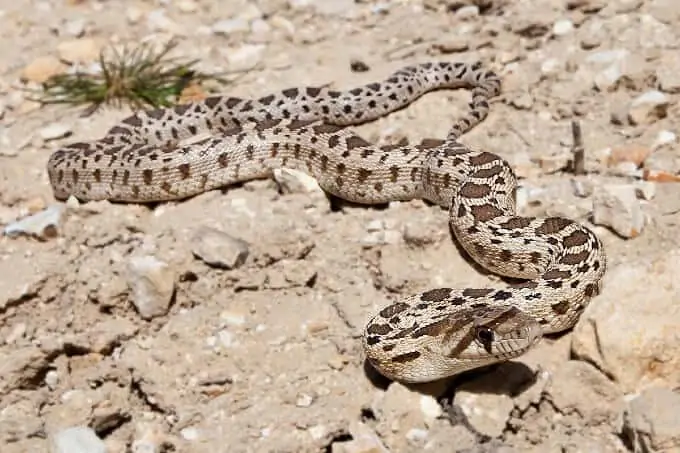
Chances are, you’ve come across this snake in the wild if you live in North America. They’re very prevalent in the wild and live in many different environments. These include sandy deserts and forests.
The standard gopher snake has a base color or tan or beige. Large brown to black splotches adorn the body, creating a distinct chain-like pattern. Several morphs exist, too. One of the most popular is Albino, which results in a bright orange coloration.
Gopher snakes are ground-dwelling constrictors. They will often burrow in the wild, so a thick substrate is essential in captivity. As you can guess from their common name, the food of choice for these snakes is rodents!
Dumeril’s Boa
The Dumeril’s boa isn’t as widespread as some other species. However, it can be a real rewarding snake to care for. This species is best-suited for reptile enthusiasts with some experience with snakes.
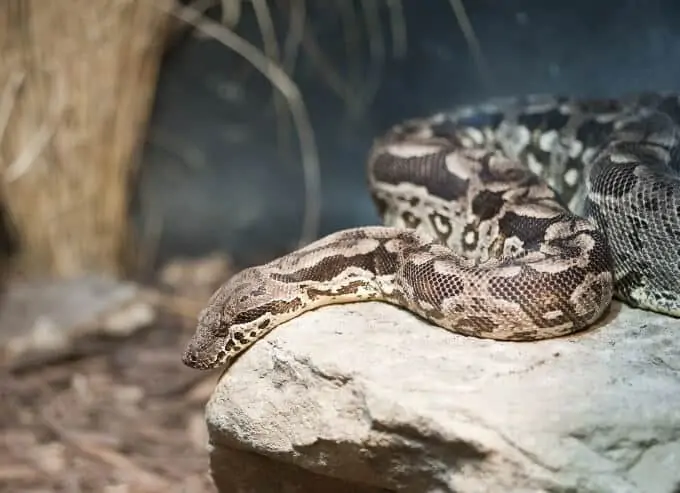
While not the most difficult pet snake to raise, they do have some distinct care requirements.
For one, they can get quite large. Adults measure between three and six feet long. As a result, you’re going to need a large enclosure to keep them comfortable.
Another obstacle that comes with caring for Dumeril’s boas is their penchant for live food. Many snakes are hesitant to accept thawed frozen mice. They like the thrill of the chase and constricting their prey on their own.
In addition to mice, Dumeril’s Boas like to eat small rabbits and fowl.
Amazon Tree Boa
The Amazon tree boa is a stunning snake with a need to climb! These snakes are arboreal and will spend most of their time wrapped around tree branches and vines.
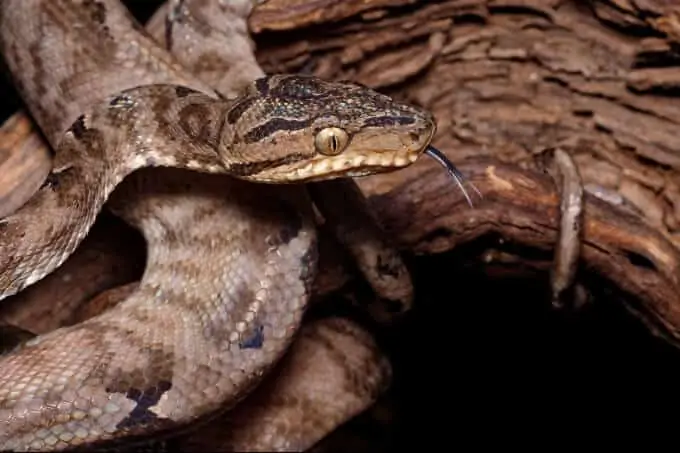
In captivity, creating suitable climbing spaces is crucial. Snakes that cannot climb will often get stressed or aggressive.
You must utilize a large enclosure with a focus on vertical space. A series of intersecting branches and vines will give the snake all of the climbing opportunities it needs.
Amazon tree boas can get quite large. Adults measure between four and five feet long on average. However, they stay pretty thin. At their thickest point, most snakes are a mere two inches in diameter.
The most common color available is brown. Though, bright green and reddish-colored snakes are available, too. Most of the snakes in the pet trade are wild-caught, so unique color morphs are very rare.
Woma Python
The woma python is a desert-dwelling snake with an appearance to match. They are usually found in the red deserts of North and Central Australia. To help the snake stay camouflaged, they have natural color patterns that mimic their wild habitat.
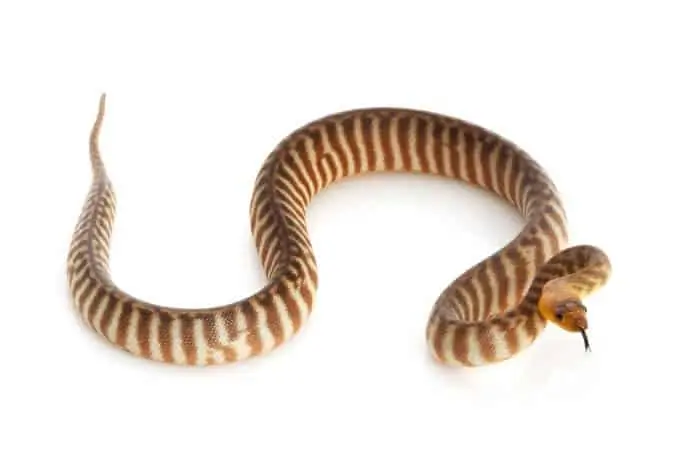
The base color is usually silver or creamy beige. Thick bands of light or dark brown lay on top. The only part that’s not covered in this color pattern is the head, which takes on a yellow hue.
While most pythons are shy and calm, woma pythons are the exception. They’re quite active. As a nocturnal species, you won’t see much activity during the day. But once the lights go out, the snake will move around the closure and even bury themselves in the substrate!
Hog Island Boa
The Hog Island boa is one of the best pet snakes that many owners dream of owning. Despite the unique name, Hog Island boas aren’t a separate subspecies. They’re classified as a morph of the common boa.
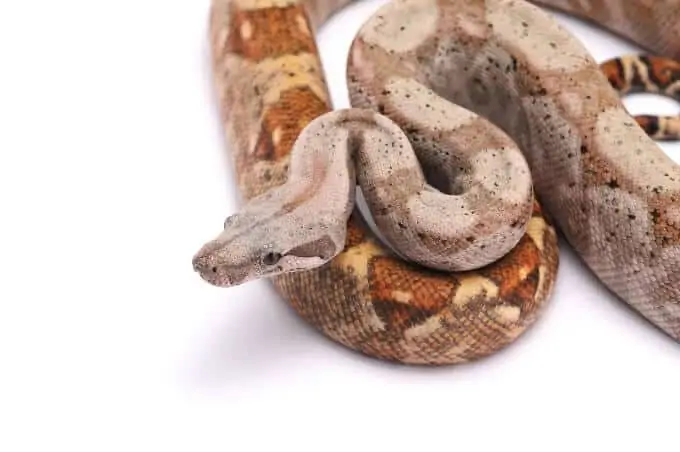
But here’s where things get interesting. This snake is only naturally found in one area. They inhabit Hog Island in Honduras. Because they are so isolated, the snake has evolved quite a bit.
They’re smaller than common boas. The snakes have a similar skin pattern to common boas, but the coloration is vastly different. Hog Island boas are hypomelanistic, which means that they don’t have black pigment. They are very light in color and look somewhat “washed out.”
Another cool thing about the Hog Island boa is its easy-going nature. In the wild, these snakes don’t have any natural predators. So, they’re fearless and more accepting of humans and other animals.
Rat Snake
The rat snake is a long and thin snake with plenty of attitude. As adults, this species usually measures around four feet in length. However, they are considerably thinner than other species.
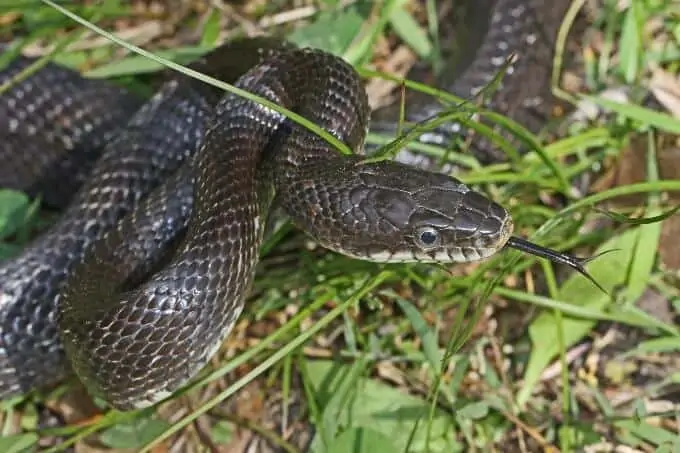
Compared to other pet snakes, rat snakes need relatively low humidity levels. Some may prefer levels as low as 30 percent. As a result, you have to work a bit harder to keep things dry.
Enclosures should have ample ventilation to help moisture evaporate. This also means that you can’t use moisture-wicking substrates. Things should be as dry as possible to avoid respiratory problems and disease.
Rat snakes are ground-dwellers that rarely climb up vertical surfaces. Though, they do like to climb on low decorations. Accessories like rocks and driftwood are always appreciated.
Kenyan Sand Boa
If you want the experience of caring for a boa constrictor but aren’t ready to own a pet snake that large, you can try the Kenyan sand boa. This species belongs to the boa constrictor family, but they are much smaller.
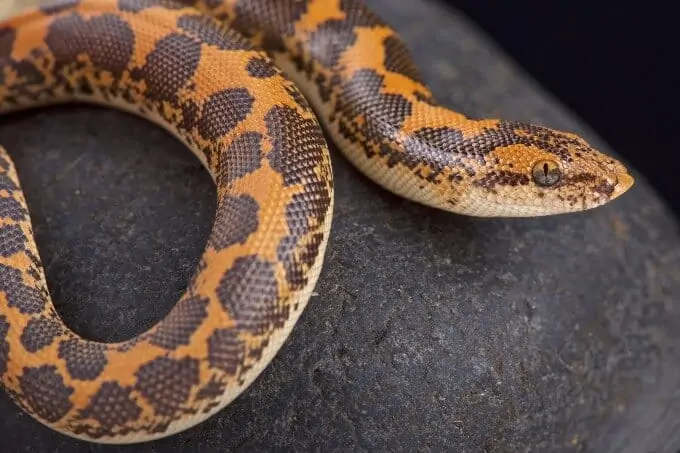
Females can reach lengths of two to three feet. Meanwhile, males rarely get past 20 inches. They’re a manageable species with all the hallmarks of a traditional Boa.
This includes the wide availability of morphs! Standard Keyan sand boas have shades of brown, black, and orange. This species is a favorite among breeders, resulting in a range of color morphs. You can find albino snakes, those with muted stripes, and snakes with bright colors like pink and orange!
For the most part, Kenyan sand boas are even-tempered. They can get stressed when environmental conditions are off. They’re also not huge fans of handling.
Ringneck Snake
This pint-sized snake is perfect for those who don’t have enough room to house a larger species. On average adults only measure 10 to 15 inches in length. The average weight? A mere 1.32 grams!
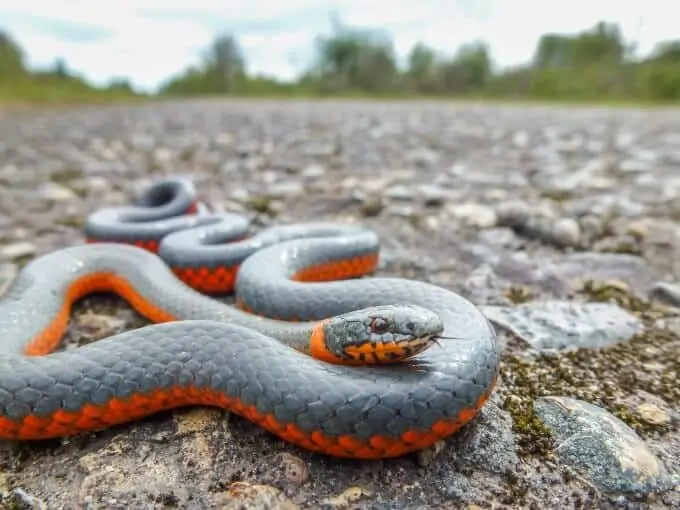
Even with its small size, the ringneck snake is a real looker! The body is usually covered in solid brown, olive green, or gray. However, a thick band of red, yellow, or orange separates the body from the head. The same color can be found on the belly. If you’re a fan of aesthetics, this is one of the best pet snakes out there!
Unfortunately, ringneck snakes don’t live very long in captivity. Lifespans can vary quite a bit based on the overall health of the snake and husbandry. On average, most will only live around six years in captivity.
Ringneck snakes are non-aggressive and social. They can live with others of the same species without any major problems.
Pueblan Milk Snake
At first glance, one could easily mistake the Pueblan milk snake as the deadly coral snake. However, the similar coloration is nothing more than mimicry at its finest. Unlike the coral snake, the Pueblan milk snake is not venomous at all.
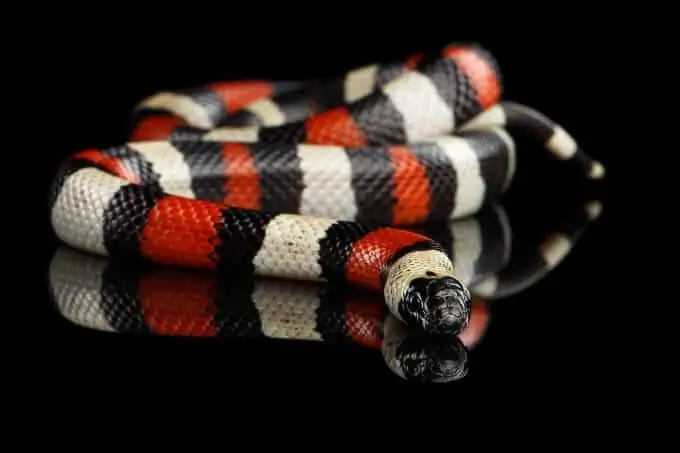
The reptiles are covered in gorgeous stripes of red, black, and yellow. They’re on the smaller side, measuring only two to four feet as adults. Thanks to their smaller size, these pet snakes are quite manageable in captivity.
Pueblan milk snakes can be rather skittish at first. They are solitary creatures that prefer to be alone. When threatened, the snake will release a pungent musk from its body.
The musk is not dangerous. However, it is a hassle to get rid of the smell!
Luckily, most snakes open up to handling the longer you care for them. They can develop a sense of trust with owners and become calmer with age.
Garter Snake
Garter snakes are another small species worth looking into. Females can get around three feet long. Meanwhile, males are usually two feet long or less.
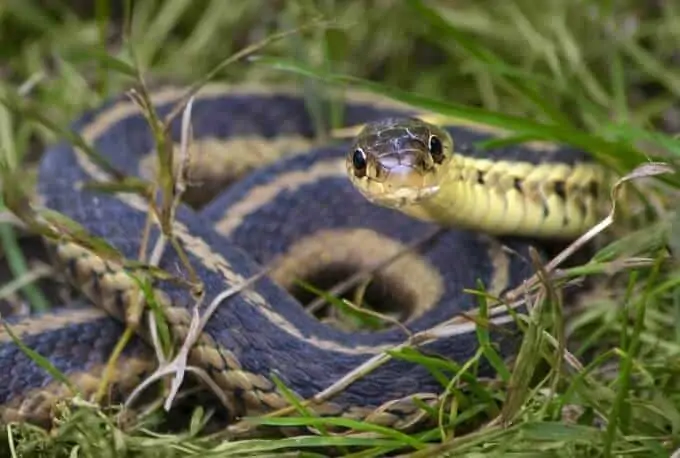
Like the ringneck snake, pet garter snakes have a relatively short lifespan. However, it’s improved over snakes that live in the wild. Wild garter snakes only live four or five years, but a well-cared-for snake in captivity can live up to 10 years!
A good enclosure for this species will have dense vegetation and plenty of branches to climb on. Garter snakes also prefer swimming space. However, it’s not necessary. A standard soaking dish will do just fine.
When it comes to temperament, garter snakes can be a bit defensive. Younger snakes are known to coil up and strike. However, this behavior usually goes away once they get older. This is especially true when handled regularly.
Carpet Python
Named after their gorgeous colors and patterns, the carpet python is a species that enthusiasts love to collect. There are many different morphs and subspecies available. These snakes can have muted colors with visually striking bands. Some can even take on bright colors like neon yellow!
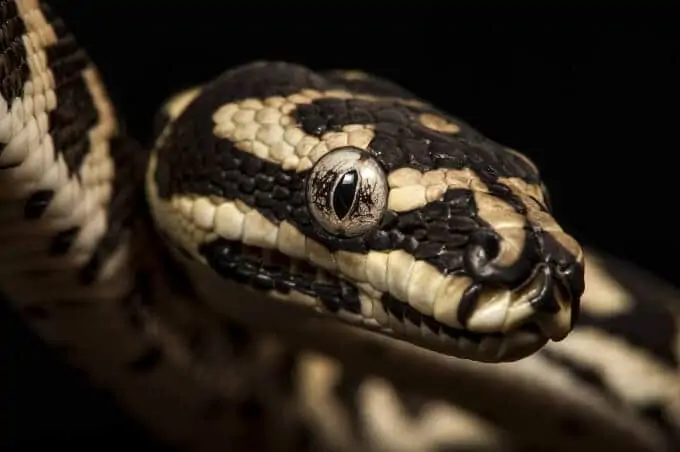
Size varies based on the subspecies. On the higher end of the scale, you have the coastal carpet python, which reaches up to nine feet long. Smaller species, such as the jaya python, are more manageable at five feet.
Semi-arboreal by nature, carpet pythons prefer to have some climbing room. They don’t need expansive branches and vines. However, some shelves and climbable enclosure accessories are appreciated.
Rosy Boa
Peaceful and easy to care for, the rosy boa is one of the best pet snakes you can get (especially if you’re a beginner). It’s a beautiful species to boot and can become a showstopper in your collection.
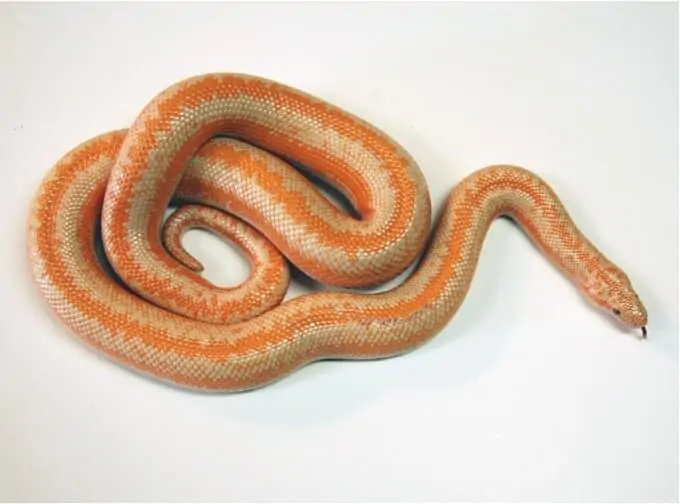
There are many different types of rosy boas. The region they come from reflects their color. Not only that, but selective breeding has resulted in some unique morphs.
Your average rosy boa is going to have a tan base color. Lateral stripes of pinkish-orange or brown run the length of the snake, creating an eye-catching look.
Rosy boas do very well in captivity. They don’t require complex decoration, but you do need to have a tight lid! These pet snakes are notorious escape artists that will take advantage of the tiniest gap to roam free.
Smooth Green Snake
The smooth green snake is a small and docile species that are native to many regions around North America. They can live in many different environments, including meadows and open woods. They often stick to moist and lush environments that are close to permanent water sources.
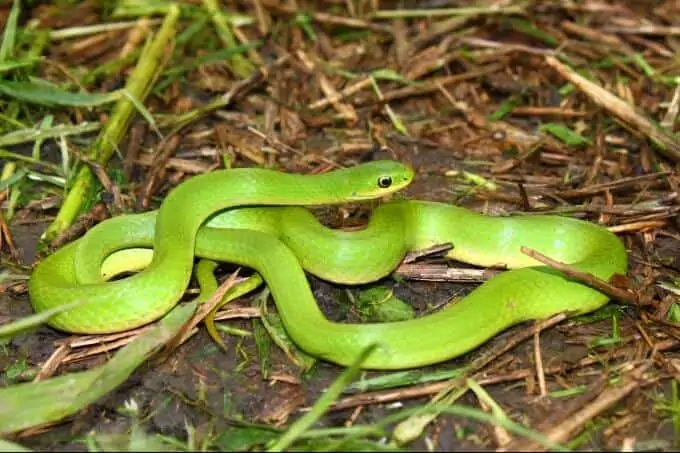
This snake is appropriately named for its appearance. They are covered in bright green scales that are uniformly colored. Not only that, but the scales on its back are very smooth to the touch.
Smooth green snakes don’t get very big. At most, they will reach lengths of only 20 inches.
These pet snakes prefer to live in solitude. They don’t like the presence of other snakes. However, they will tolerate interaction from humans.
They rarely bite, choosing to flee instead when threatened. They may also release some musk from their anal glands to scare off potential predators.
Colombian Rainbow Boa
While not as common in the pet trade, Colombian rainbow boas are highly sought after. Take one look at them and it’s not hard to see why!
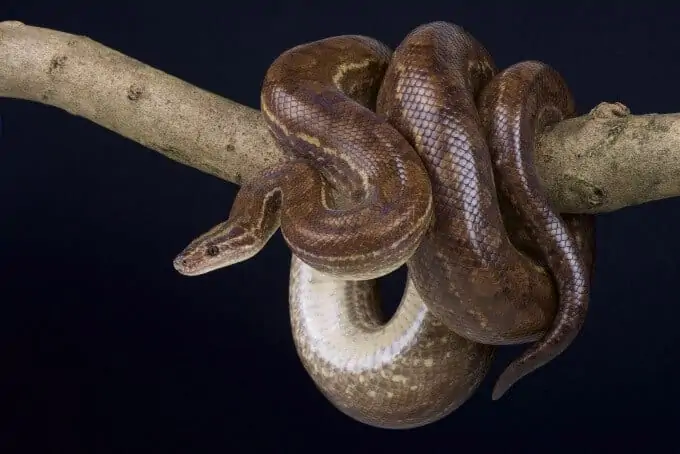
At first glance, the Colombian rainbow boa looks like any other common boa. It has a light brown color with some darker vertebral rings. However, the scales have a unique finish to them. In the light, you’ll notice an iridescent sheen that reflects the color spectrum.
Colombian rainbow boas are semi-arboreal. They prefer to have a network of branches to climb up when they want to get off the ground. When they’re not climbing, the snake likes to curl up in hiding boxes or artificial caves.
Overall, this is a good pet snake because they’re quite peaceful. That said, their docile behavior can fade at times. Juveniles can be a bit nippy and aggressive before maturing.
Green Tree Python
Often considered one of the most beautiful snake species around, the green tree python is a beautiful pet to care for. They come from New Guinea and Northern Australia. Usually, you can find them living in lowland scrubs or forests.
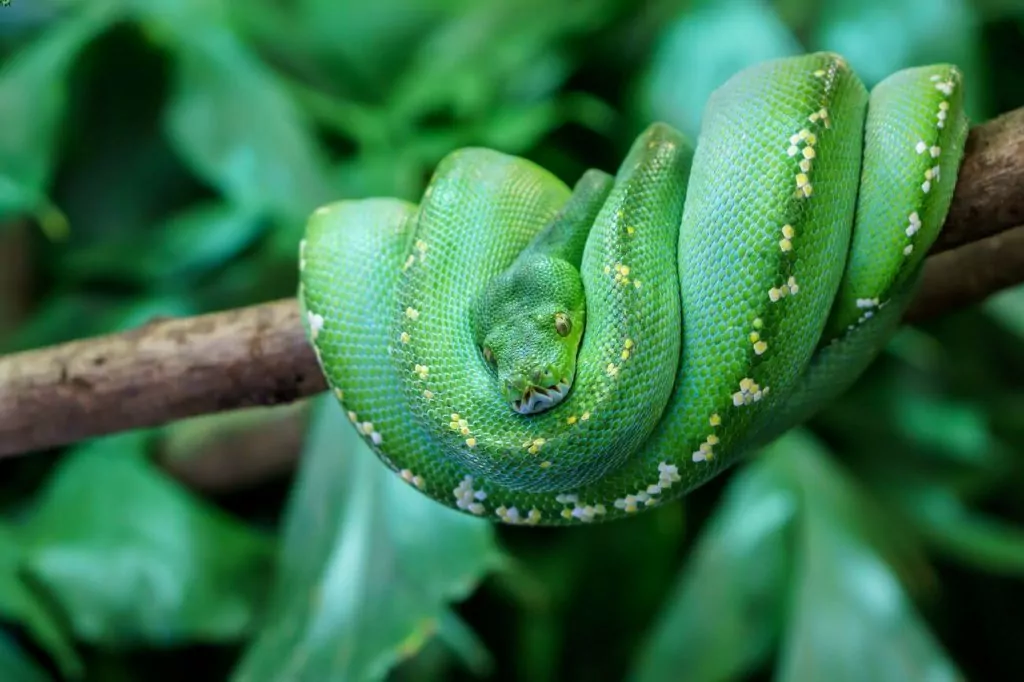
While there are a few different variations available, the standard green tree python is the most iconic. Most of the body is covered in light screen scales. However, sporadic blue and white scales adorn the body. This creates a stunning spotted pattern.
You can also find bright yellow snakes with spots of green or white snakes with yellow and blue.
Climbing is the name of the game with green tree python. In captivity, closures must have several sturdy branches for the snake to rest on. Usually, the snakes will curl up on those branches to bask.
Brazilian Rainbow Boa
Not to be confused with their close cousin, the Brazilian rainbow boa is a unique snake in its own right. This species looks strikingly similar to the Colombian rainbow boa, but the biggest difference comes down to color.
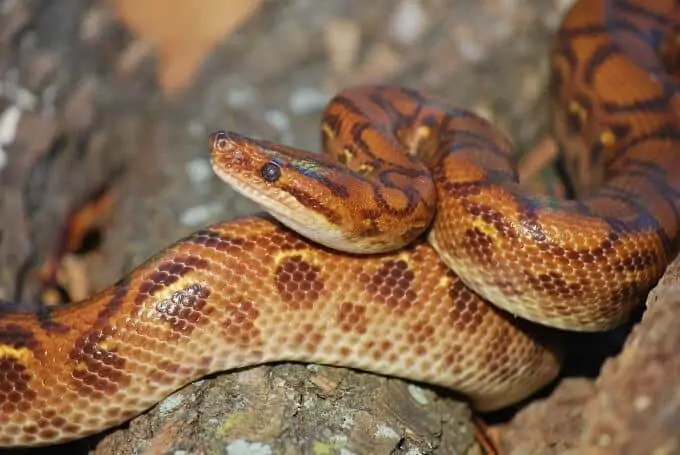
Brazilians have more color variation in them. You will often see more vivid patterns and different shades of maroon and mauve. Of course, they also have that layer of iridescent scales.
Coming from the jungles of Brazil, these snakes need a hot and humid environment. They require hot basking areas and humidity levels as high as 75 percent.
These snakes are largely terrestrial, but they do like to climb every once in a while. So, having some climbing vines and perches are a must.
When first introduced to a new environment, Brazilian rainbow boas can be a bit defensive and nippy. Luckily, they quickly mellow out and don’t mind being handled.
False Water Cobra
Based on the name alone, the false water cobra sounds like a scary snake to own. However, it actually makes a great pet!
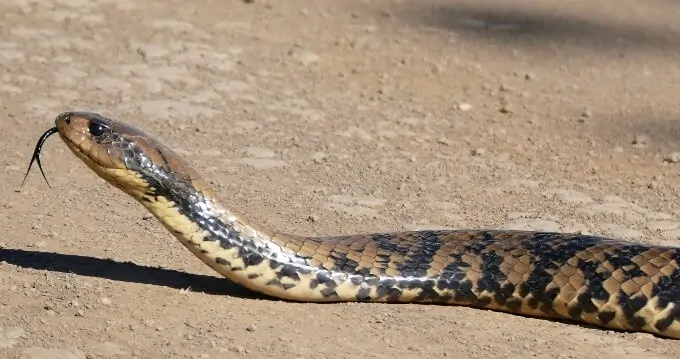
These snakes are not true cobras. They don’t even belong to the same family. They can, however, produce venom.
False water cobras will use venom when attacking prey and eating. Some can be released during a bite on humans as well. Fortunately, bites in captivity are rare. They usually only occur when you agitate the snake or catch it by surprise.
Even if they do bite you, these attacks are quick. Thus, most don’t even react to the venom at all.
This species can get pretty big. Females may reach lengths of up to eight feet. Males stay around four and five feet long.
Thanks to their large size, false water cobras can be a handful to care for. But if you handle their needs, they can be a joy to own.
Egg-Eating Snake
Naturally found throughout sub-Saharan Africa and the Middle East, egg-eating snakes have some unique husbandry needs. These reptiles don’t eat mice or rodents. Instead, they rely on a diet of fresh eggs!
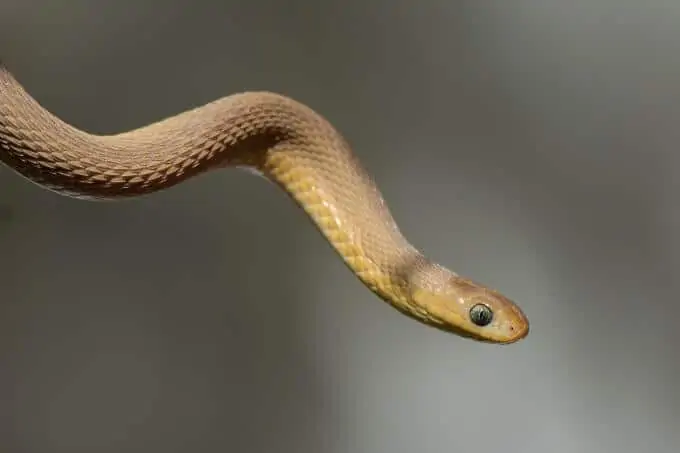
Egg-eating snakes are comparatively small. As adults, they don’t even make it to three feet. Most will stay between 24 and 30 inches long.
Because of its small size, you must choose egg meals carefully. They cannot consume standard chicken eggs you get at the grocery store. Those eggs are far too large. However, eggs from smaller animals like quail, finches, and canaries work well.
Most egg-eating snakes in the trade are wild-caught. The species is known for being a bit skittish and defensive in the beginning, but they will get more comfortable with time and allow human handling.
Picking The Best Pet Snake For You
There are a number of factors to consider when deciding which type of pet snake is best for you. While we tried to make things easy by covering the basics when it comes to each species on our list, we know that still leaves you with a lot of options.
So to help you decide, we’ll cover the simple formula to help you pick a pet snake that’s right for you.
First, if you’re a beginner there are a few types of snakes we recommend. They are:
- Ball python
- California kingsnake
- Corn snake
- Gopher snake
- Rosy boa
These are all really good beginner snakes due to their ease of care. You won’t be overwhelmed as you learn the ropes, and they will still provide you with a great deal of joy!
If you’re not a beginner, then you’ll want to consider a few things.
The first is how much space and time you have to care for your pet. You could have all the experience in the world, but if you work long hours and live in a studio apartment it’s not smart to get a massive snake that needs lots of attention.
Once you’ve found a snake that fits with your lifestyle, it’s all about personal preference. The behavior and look of a species is usually what will draw you in.
Don’t overthink this. Go with your gut and enjoy yourself!

